As a progressive livestock farmer, you know how vital your pasture is. You know that your pasture is a quality source of nutrition for your animals. And you know that it can help you lower your feed expenses.
But getting enough pasture for your animals isn’t always obvious or easy. In the art of grazing management, there are several variables. But only a few are important, so let’s talk about the three most essential variables in grazing management:
- Selecting pasture types
- Managing grazing plans and yields
- Improving and maintaining soil fertility
- Measuring pasture frequently and accuratly
Unlike other factors such as rainfall, weather changes and market prices, you can control these three factors to a large extent. And if managed well, they can improve annual yields to more than 10,000 Kg DM/ ha.
So, let’s talk about them:
1. Pasture Species
Pastures differ from country to country and from region to region.
It changes because of factors like rainfall, humidity, max summer temperatures, and soil profile vary.
So why is selecting the right species for your pasture so very important?
Because most ruminants graze for about 7 to 8 hours a day – irrespective of pasture quality or available forage, no more, no less. So, we can either use this to our advantage or not.
If your animals graze on poor pastures, they will not meet their nutritional requirements, and you’ll have to spend more money and effort supplementing their diets with concentrates.
On the other hand, if you grow high-quality forage on your pastures – you will be able to maximise both animal health and production. But to do this, you’ll need a range of different pasture species.
Let’s look at three broad groups of pasture species:
#1 Native pasture species:
These are the plants that exist naturally in your bioregion. So, they adapt to your local climate and soil profile. They are incredibly hardy and resilient.
They are the type of plants that can survive hot summers and periods of heat stress. You might have noticed that some of your native species get through summer even without any fertilisation or irrigation.
However, overgrazing can significantly damage native species and alter your pasture composition permanently.
Also, they may not be your best bet when it comes to providing maximum yields. That’s because they don’t increase yields dramatically when irrigated or fertilised.
That’s why you might have to introduce other non-native pasture species such as legumes or different improved varieties. We cover both next.
#2 Legumes in your pasture:
Read any book, guide or post around pastures, and you’ll find legumes mentioned in it. That’s because mixing in legumes along with your pasture offers several advantages.
Legumes are a rich source of protein. As you know, your animals need around 12% to 18% of quality protein in their feed. So, legumes can cover the protein needs of your animals to a large extent.

However, protein-rich feed doesn’t come cheap. To give you some context, a protein-rich feed like soybean meal will cost you more than 400 dollars per ton. So, legumes in your pasture help you improve animal health and also to reduce your feed costs.
Legumes are also a great addition to your soil. The Nitrogen-fixing rhizobium bacteria nodules convert Nitrogen gas into Ammonia and increase N uptake by all surrounding plants. So, the right mix of legumes can ensure healthier pastures and lower N fertilisation costs.
Also, most legumes need fairly minimal irrigation and fertilisation to produce well.
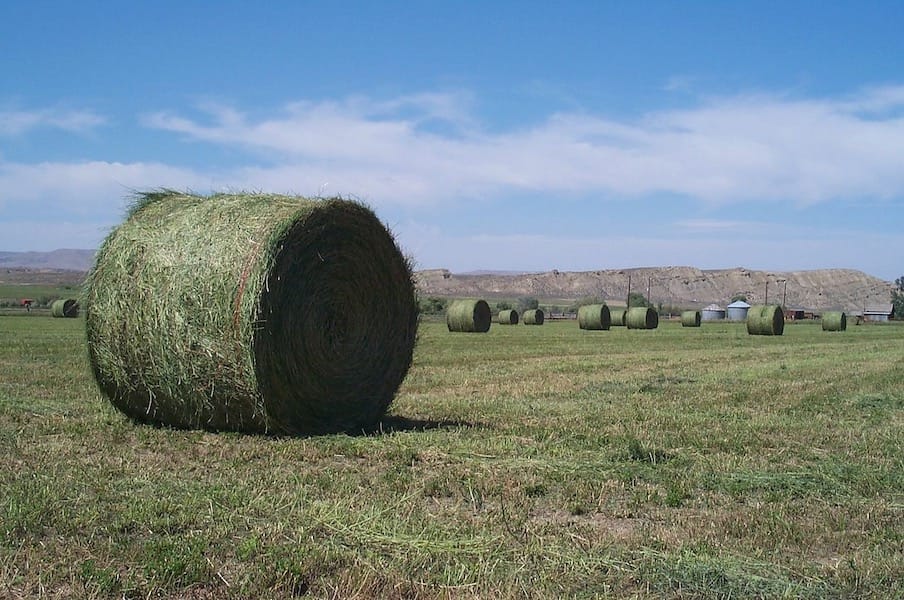
But even more importantly, legumes such as lucerne, cowpea, soybean and groundnut grow well in the warm season, throughout summer. This understanding can boost your overall annual yields, even as your cool-season grasses begin to drop their yields in summer.
But legumes alone may not be enough too. Because, some of them have very low TDN values, and excessive consumption of legumes may cause bloat in your animals.
That’s why you may also need to add improved species in your mix.
#3 Cool and warm-season pasture species:
As we all know, spring is the best season for your pasture. The temperature is just right, the sun is out, the birds are chirping (well that does make it more fun, doesn’t it) and your pastures are doing well.
More often than not, there are surplus yields in spring, because your pasture produces more than what your animals can eat. This surplus is usually stored as hay or silage that can be used in the summer when things get hot, and your cool-season grasses begin to die out.
However, with a little planning, you can still keep a productive pasture through the entire summer.
You can even achieve surplus summer yields by sowing warm weather-loving summer grasses and legumes such as Bermudagrass, Indiangrass, Sorghum-sudangrass and cowpea during mid-spring.
This surplus can then be stock-piled or harvested as hay and silage. And in turn, can help you augment your animal’s nutritional needs during autumn.
Cool-season perennial forages like ryegrass, bluegrass, orchardgrass, fescues, timothy, bromegrass, birdsfoot trefoil and clover thrive in colder weather.
About 70% of their growth is in the early grazing season, around spring, when the temperatures don’t get hot. A spurt of productivity follows summer during autumn. As the heat goes up, the growth of the grasses goes down.

And that’s when the warm season varieties such as sudangrass and millets can take over.
Millets are incredibly hardy crops that can tolerate a high degree of heat stress. This characteristic is why they are extensively grown in the hot tropics of Asia and Africa, where most other crops can’t do well.
Millets such as foxtail millet, pearl millet, proso millet and sorghum (aka great millet) all offer high yields greater than 8,000 Kg DM/ ha in summer conditions. But even more importantly, they provide excellent nutrition value. And also store well as hay.
TO LEARN MORE ABOUT INCREASING YIELDS IN SUMMER, READ:
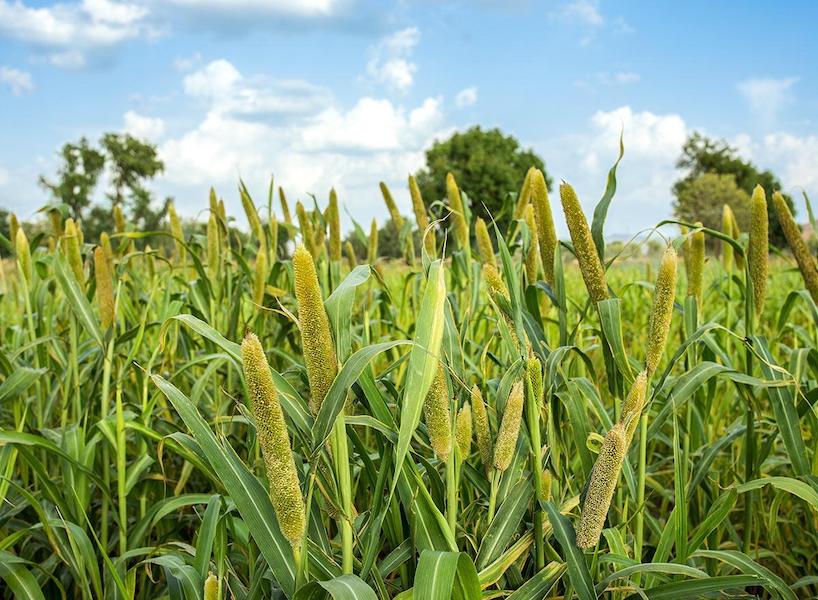
Sometimes millets are crossed with other warm-season grasses for fodder purposes. The best-known example is hybrid sorghum-sudangrass. These hybrids are tall, fast-growers that love sunny weather.
They also quickly smother out weeds, suppress some species of nematodes and even open out compacted subsoil. If it’s allowed to grow till maturity, summer species like sorghum-sudangrass can easily reach heights of 8 – 12 ft!
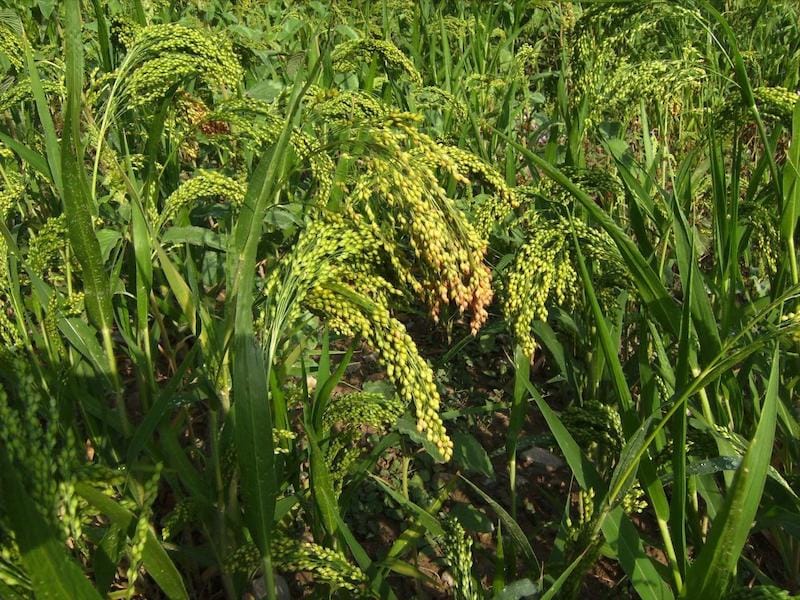
As you can see from the below graph, cool or warm-season species alone aren’t enough to give you high yields throughout the year. That’s why you need to plan the transitions between them, just like how relay racers pass the baton in a race.
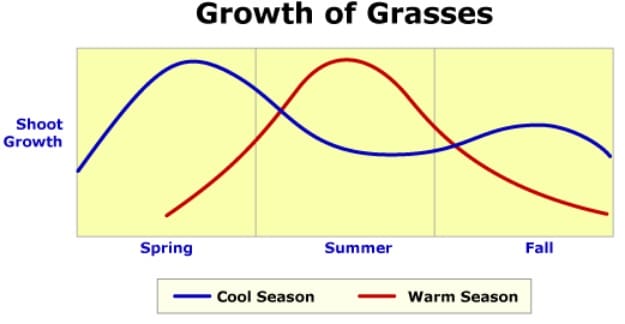
This understanding will help you maintain high pasture yields throughout the year. And boost overall annual yields significantly.
But even the right mix of species can result in lower yields, especially if your soil fertility isn’t maintained or if you don’t have a sound rotational grazing plan in place. Both are covered next.
TO LEARN MORE ABOUT SELECTING PASTURE TYPES, READ:
2. Grazing Plans
Your animals can sometimes overgraze your pasture down to its roots.
And at other times, they can under graze your pastures, leaving out too much to rot.
Overgrazing leads to plant damage, slower recovery and growth rates. This outcome means lower annual yields.
Under grazing, on the other hand, means that your animals have a choice to eat only their favourite species, thus depleting them faster and allowing the different species to get better established and out-compete the favourable ones eventually.
You want neither. Instead, you want your pre-grazing covers to be around 3,000 Kg DM/ ha. And you would want your post-grazing residuals to be approximately 1,500 Kg DM/ ha.
Here are some practical tips to help you achieve this in practice:
Make use of animal grazing patterns:
Most livestock prefer not to graze during the hottest part of the day, so they feed most of their fodder just after sunrise, until noon. Grazing increases again as temperatures drop towards evening.
A third grazing period may occur around midnight. On average, 60% of grazing occurs during the day, and 40% occurs during the night with livestock spending more time grazing at night following hot days.
In sweltering heat, animals need abundant water and may benefit by being moved to shade during the hottest hours of the day.
Practice Rotational Grazing
Put merely, rotational grazing involves a defined period of grazing followed by a planned period of rest.
The rest period is generally based on how quickly the pasture regrows. As one can imagine, this regrowth is dependent upon the growth rate, type of plant species and weather conditions.
When compared to open or continuous grazing, rotational grazing offers superior benefits in terms of improved nutritional outcomes, dry matter yields, water quality, pasture quality, and soil fertility.
THERE ARE SEVERAL ROTATIONAL GRAZING SYSTEMS. IF YOU’RE INTERESTED TO LEARN MORE ABOUT THEM, CONSIDER READING:
- Principles of Intensive Rotational Grazing
- How rotational grazing can help you improve pasture utilisation
- The Psychology of Livestock Fencing During Rotational Grazing
- How often should you rotate your cows
- Water in rotational grazing – are your cows getting enough?
- Grazing strategies to control weeds
- Essential Tips For Summer Grazing
- How many acres of pasture do your cows need?
- Preventing pasture bloat in cattle grazing Lucerne
But quickly, here are the most widely used rotational grazing systems:
- Time-based rotational grazing
- Herbage-based rotational grazing
- Creep grazing
- Cell grazing
- Strip grazing
- Mob grazing
- Leader-follower grazing
- Rest rotation grazing
- Techno grazing
- Conservation grazing
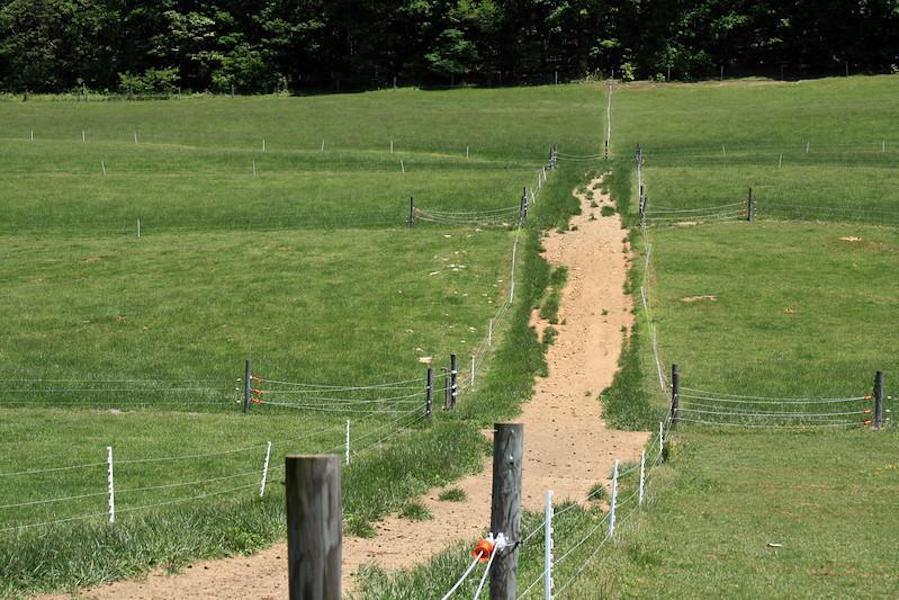
Each of these ten rotational grazing systems has its own set of advantages and disadvantages. Some offer superior yields but are more expensive and might need more intensive management than other methods.
So, it is essential to choose a system that works for you and your needs.
As long as you can provide:
- Enough rest for your pasture to recover and regrow.
- Ensure optimum pre-grazing covers and post-grazing residues.
Okay, that’s a good theory. But how to implement this practice? By designing your paddocks, that’s next.
Especially considering that different pasture species grow differently in different seasons.
We talk about this next.
Design your paddocks to meet your needs
There is no “best” number of paddocks. Any number of paddocks is better than grazing a single pasture continuously.
Initially, the number of paddocks in your rotational system may be determined by current fences, topography, access to water or access to a central collection corral or yard (as discussed in the next section).
Such a multiple paddock system will significantly increase both pasture condition and animal performance. The next step is to move into an intensive grazing system and let the length of grazing and rest periods determine the number of paddocks.
Dividing a pasture into more paddocks increases the length of the rest period and decreases the length of time an area is grazed (figure 10).
More paddocks are usually better than fewer for both the animals and the plants. But paddock numbers don’t need to be rigid; they may be fenced with portable electric wire so that size and number may be changed as required.
To determine the ideal number of paddocks for an intensive rotational grazing system, you need to do the following:
One, estimate the length of your most extended rest period (during the slowest period of forage growth).
Two, estimate the length of your grazing period, and the number of animal groups which will be grazing the same pasture sequentially.
Then use the below equation to calculate how many paddocks you’ll need:
Number of paddocks = (rest period) + (number of (grazing period) animal groups)
For example, a pasture with 30-day rest periods and 3-day grazing periods that is grazed by one animal group should be divided into 11 paddocks ((30 ÷ 3) + 1).
Fencing your paddocks
Good fencing is a must in rotational grazing systems. The fencing system used for rotational grazing includes a permanent perimeter fence as well as permanent or movable fencing to separate paddocks.
Most farmers use permanent fencing for perimeter fences and movable fencing for individual paddocks. Other farmers have chosen to construct permanent paddocks for all or part of their pastures.
The advantage of permanent paddocks is that, once they are established, fences do not have to be moved.
If your livestock numbers don’t change that much and you are experienced in rotational grazing, this may be a viable option.
Don’t let your current fencing arrangement limit you—fence in a way that makes the best use of your land.
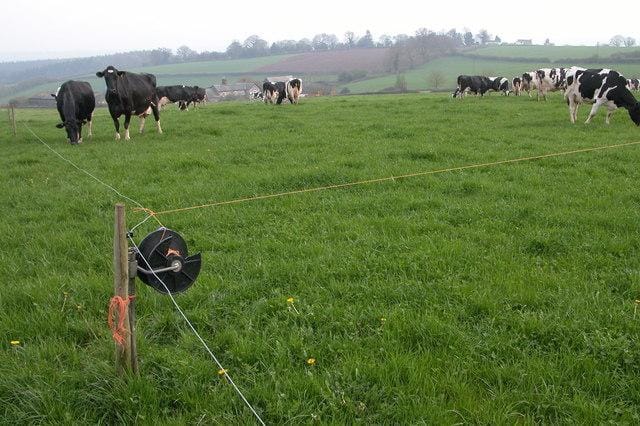
With movable fencing, you can easily alter paddock size to meet changing conditions of forage growth or herd size. Pasture divided into temporary paddocks is easily accessed by machinery or can quickly be taken out of the pasture.
Portable wires and tapes are made of polyethylene embedded with stainless steel strands (the greater the number of metal strands, the longer it will last). Braided polywire is available in a variety of colours and lengths.
Brightly coloured tape is more easily seen by livestock and can be used to train animals initially.
Seasonal grazing plan changes
Earlier, we already spoke about changing your pasture species concerning seasons. In addition to this, you might also need to make a few seasonal adjustments to your grazing plans.
This is important because your yields won’t match your animal needs throughout the entire year. So let’s look at a few broad changes in grazing management, across the four seasons of a cool-temperate pasture.
In spring, you might need to implement quick grazing rotations to ensure that your pastures don’t overgrow beyond 3,000 to 3,500 Kg DM/ ha. You might also want to earmark a few paddocks exclusively for hay or silage making.
Following that, in summer, you might face an entirely new challenge. Most of the time, you might be working to ensure that your pastures don’t get overgrazed below 1,500 Kg DM/ ha. If you’ve planted summer species, you’ll be looking to get a harvest from that. And you might also be thinking about buying additional feed for winter.
In autumn, you might be thinking about silage harvesting and reseeding your paddocks, where necessary.
And during winter, you would want to provide maximum rest and recovery periods to match the slow grass growth rates. However, with the right measures, winter can still be a productive season. To learn more about this, read Winter Grazing Strategies That Work and How to make sure your pasture and cattle complement each other in winter.

3. Improving and maintaining soil fertility
To produce high yields, year after year, your plants need several significant nutrients such as Nitrogen (N), Phosphorus (P), Potassium (K), Sulphur (S) and Magnesium (Mg) from your soil.
You need to replenish these nutrients as and when required, either through compost or fertilisers.
Seen in this light, fertiliser management becomes a critical part of your pasture and grazing management plans. Typically, fertilising accounts for around 15% of a dairy farm’s operational expenses.
Also, the more intensively you graze or harvest your pastures, the more attention you will need to give towards fertiliser management.
In addition to fertilisers, you also need a lot of organic matter in your soil. Organic matter gradually decomposes to form organic carbon. Think of organic carbon as a giant natural sponge — a sponge that soaks up and stores nutrients as well as moisture.
The more organic carbon you have, the more nutrients, moisture and soil life you’ll have. This understanding, in turn, improves and maintains the long-term fertility of your soil.

One of the best sources to increase organic carbon and soil life is to grow more trees. Growing trees on about 10% of your farm can help you add a lot of organic matter without any dry matter yield losses.
Another good source to add nutrients and organic matter is to reuse animal effluents on your pasture.
MORE ON REDUCING SOIL DAMAGE WITH APPROPRIATE GRAZING MANAGEMENT:
4. Using frequent and accurate pasture growth measurements
As we come to the end of this guide, let’s do a quick recap of what we’ve covered so far:
- You learnt that you need a mix of natives, legumes, warm-season and cool-season pasture species.
- You also learnt that you need to implement sound rotational grazing plans to get better outcomes.
- You learnt that you need to replenish organic carbon and nutrients to improve and maintain fertility.
But there’s also another last piece in this puzzle of effective grazing management. And that is pasture growth measurements.
You already know that different pasture species grow differently in different seasons. You also understand that you will need to adjust your grazing management plans according to your production needs (think calving, contracts with your co-operative, etc.).
And finally, you’ll need to adapt your grazing management plans based on unexpected events such as a disease outbreak or drought or flood.
So, in essence, you need a baseline, you need a scorecard to base your grazing management decisions. And that reliable indicator can be your pasture growth measurements.
Your pasture growth measurements show how well your grazing plans are performing. They also show how your farm is holding up to your local weather. And they show how your soil fertility is changing.
Of course, for pasture growth measurements to work, they need to be both accurate and frequent. Weekly growth measurements that are accurate to about plus or minus 50 Kg DM/ ha work best.
But, measuring your entire pasture manually every week can be an UDDER PAIN. Not to mention that it can cost you upwards of 5,000 dollars a year in labour alone.
That’s why we built pasture.io to help you get accurate and cost-effective pasture growth measurements, several times a week, automatically on your phone and computer.
If interested, do check our plans. We have a forever free plan. And a paid program that costs $1099 plus $8 a hectare. Our customers routinely get a 40X return on the money they invest with us. You too can.
That brings us to the end of this free guide. I hope it was useful for you. If you have any questions, leave them as a comment below, and I’ll answer it for you.
Until we meet again, happy farming.
5. Additional Reading Resources
-
Tactical Grazing Management: Meet Your Growth Targets
-
Principles of Intensive Rotational Grazing
-
Winter Grazing Strategies That Work When it Snows
-
How to make sure your pasture and cattle complement each other in winter
-
Sorghum-sudangrass: the sunny summer cocktail that every farmer's talking about!
-
Stay On Top Of Your Summer Grazing Game!
-
The Psychology of Livestock Fencing During Rotational Grazing
-
Using summer Annuals to extend your grazing season
-
How You Plan Your Grazing is Key to Leaf Emergence and Plant Growth
-
How rotational grazing can help you improve pasture utilisation
-
How often should you rotate your cows
-
Water in rotational grazing – are your cows getting enough?
-
Pasture Selection for Dairy Cows
-
Lucerne for Dairy and Beef Farming
-
Preventing pasture bloat in cattle while grazing Lucerne
-
Lucerne as cattle feed
-
How many acres of pasture do your cows need?
-
Grazing strategies to control weeds
-
Grazing management to reduce soil damage
-
Practical Implementation of Deferred Grazing
-
Benefits of Deferred Grazing on Native Pastures
-
5 autumn grazing principles for successful farming
-
The Predictive Feed Wedge with Pasture.io
-
Winning Autumn Grazing Strategies
-
How to graze when soils are saturated
-
5 Cool Tips for Winter Grazing
-
Essential Tips For Summer Grazing































